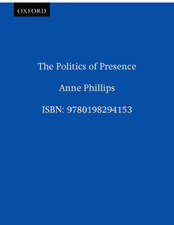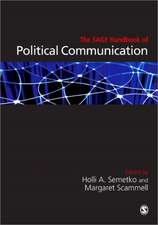Techno Politics in Presidential Campaigning: New Voices, New Technologies, and New Voters
Editat de John Allen Hendricks, Lynda Lee Kaiden Limba Engleză Hardback – 8 noi 2010
| Toate formatele și edițiile | Preț | Express |
|---|---|---|
| Paperback (1) | 298.10 lei 6-8 săpt. | |
| Taylor & Francis – 8 noi 2010 | 298.10 lei 6-8 săpt. | |
| Hardback (1) | 767.93 lei 6-8 săpt. | |
| Taylor & Francis – 8 noi 2010 | 767.93 lei 6-8 săpt. |
Preț: 767.93 lei
Preț vechi: 1029.61 lei
-25% Nou
Puncte Express: 1152
Preț estimativ în valută:
146.96€ • 152.86$ • 121.33£
146.96€ • 152.86$ • 121.33£
Carte tipărită la comandă
Livrare economică 14-28 aprilie
Preluare comenzi: 021 569.72.76
Specificații
ISBN-13: 9780415879781
ISBN-10: 0415879787
Pagini: 272
Ilustrații: 26 tables
Dimensiuni: 152 x 229 mm
Greutate: 0.66 kg
Ediția:1
Editura: Taylor & Francis
Colecția Routledge
Locul publicării:Oxford, United Kingdom
ISBN-10: 0415879787
Pagini: 272
Ilustrații: 26 tables
Dimensiuni: 152 x 229 mm
Greutate: 0.66 kg
Ediția:1
Editura: Taylor & Francis
Colecția Routledge
Locul publicării:Oxford, United Kingdom
Public țintă
PostgraduateCuprins
Preface
New Technologies
Chapter 1 "Shaping the New Presidential Campaign"
Chapter 2 "From Soundbite to Textbite: Election ’08 Comments on Twitter"
Chapter 3 "The Web 2.0 Election: Voter Learning in the 2008 Presidential Campaign"
Chapter 4 "Evaluating Candidate E-Mail Messages in the 2008 U.S. Presidential Campaign"
New Voices and New Voters
Chapter 5 "Campaign 2008: Comparing YouTube, Social Networking and Other Media Use Among Younger and Older Voters"
Chapter 6 "When Bloggers Attack: Examining the Effect of Negative Citizen-Initiated Campaigning in the 2008 Presidential Election"
Chapter 7 "New Voices and New Voters: Ethno-Technology in Reactions to Candidate Messages in the 2008 Campaign"
New Technologies and New Voices in Debates
Chapter 8 "CNN’s Dial Testing of the Presidential Debates: Parameters of Discussion in Tech Driven Politics"
Chapter 9 "New Media’s Contribution to Presidential Debates"
Chapter 10 "The Biden-Palin 2008 Vice Presidential Debate: An Examination of Gender and Candidate Issue Expertise"
Media Representations and Voter Engagement
Chapter 11 "Just a Hockey Mom with a Gun: Competing Views of Sarah Palin on CNN and FOX"
Chapter 12 "International Coverage of the U.S. Presidential Campaign: Obamamania Around the World"
New Technologies
Chapter 1 "Shaping the New Presidential Campaign"
Chapter 2 "From Soundbite to Textbite: Election ’08 Comments on Twitter"
Chapter 3 "The Web 2.0 Election: Voter Learning in the 2008 Presidential Campaign"
Chapter 4 "Evaluating Candidate E-Mail Messages in the 2008 U.S. Presidential Campaign"
New Voices and New Voters
Chapter 5 "Campaign 2008: Comparing YouTube, Social Networking and Other Media Use Among Younger and Older Voters"
Chapter 6 "When Bloggers Attack: Examining the Effect of Negative Citizen-Initiated Campaigning in the 2008 Presidential Election"
Chapter 7 "New Voices and New Voters: Ethno-Technology in Reactions to Candidate Messages in the 2008 Campaign"
New Technologies and New Voices in Debates
Chapter 8 "CNN’s Dial Testing of the Presidential Debates: Parameters of Discussion in Tech Driven Politics"
Chapter 9 "New Media’s Contribution to Presidential Debates"
Chapter 10 "The Biden-Palin 2008 Vice Presidential Debate: An Examination of Gender and Candidate Issue Expertise"
Media Representations and Voter Engagement
Chapter 11 "Just a Hockey Mom with a Gun: Competing Views of Sarah Palin on CNN and FOX"
Chapter 12 "International Coverage of the U.S. Presidential Campaign: Obamamania Around the World"
Notă biografică
John Allen Hendricks is Director of the Division of Communication and Contemporary Culture, and Professor of Communication at Stephen F. Austin State University. He is the co-editor of the book Communicator-in-Chief, and he has published numerous journal articles and book chapters on political communication. He is also the author of The Presidency and Social Media.
Lynda Lee Kaid is Professor of Telecommunications and Research Foundation Professor at the University of Florida. A Fulbright Scholar, she has also done work on political television in European, Asian, and Latin American countries, and is the author/editor of more than 25 books on political advertising and political communication.
Lynda Lee Kaid is Professor of Telecommunications and Research Foundation Professor at the University of Florida. A Fulbright Scholar, she has also done work on political television in European, Asian, and Latin American countries, and is the author/editor of more than 25 books on political advertising and political communication.
Recenzii
"The text should be valuable to scholars in political science and communication as a primer for what will surely be exponential growth in technological innovation in presidential elections for years to come." - Pete Bicak, Communication Research Trends
Descriere
This volume examines the use of new media and technologies to reach voters in the 2008 US Presidential campaigns, and the role these tactics played in attracting new voters and communicating with the electorate. Chapters focus on how the technologies were used by candidates, the press, and voters.










